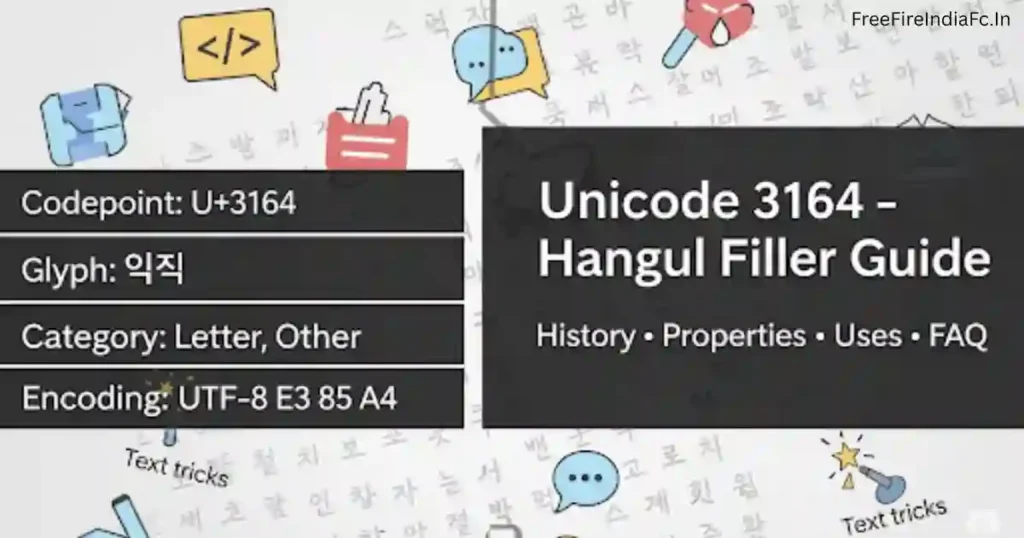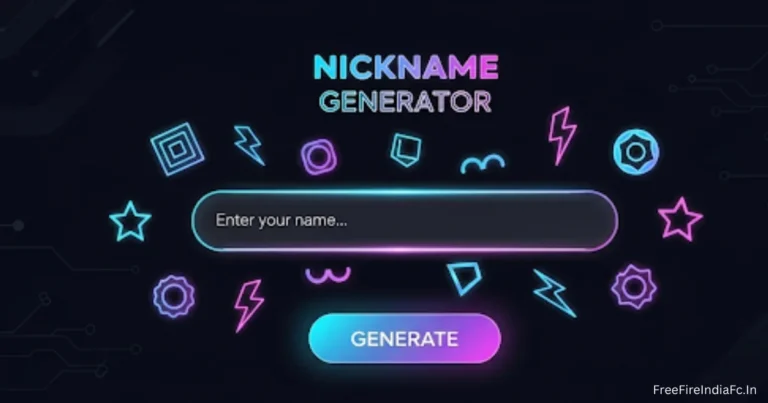Unicode 3164 – Hangul Filler: History, Properties, and Modern Uses
When we talk about Unicode, most people think of emojis, letters, or scripts like Devanagari, Chinese, or Arabic. But hidden inside Unicode are some very unusual characters that don’t look like much—yet play an important role in how text is represented across systems. One such character is Unicode 3164, officially known as the Hangul Filler.
At first glance, Unicode 3164 looks like nothing at all. It renders as a blank, yet it isn’t a space. Instead, it’s a compatibility character used in the Korean writing system to make sure legacy encodings remain fully supported in modern computing. Over time, this character has also been creatively misused for tricks like invisible usernames, blank messages, and more.
📊 Quick Facts Table – Unicode 3164
| Property | Value |
|---|---|
| Codepoint | U+3164 |
| Glyph | ㅤ |
| Official Name | Hangul Filler |
| Block | Hangul Compatibility Jamo (U+3130–U+318F) |
| Category | Letter, Other (Lo) |
| Script | Hangul |
| Introduced | Unicode v1.1 (June 1993) |

History and Standardization
Unicode 3164 was introduced in Unicode 1.1 back in 1993. Its primary reason for existence was compatibility with older Korean standards, particularly Wansung (KS X 1001) encodings.
In Korean Hangul, syllables are composed of an initial consonant, medial vowel, and optional final consonant. But older encoding systems stored these in fixed-length sequences. To maintain “round-trip” compatibility when converting between old systems and Unicode, the Hangul Filler was used as a placeholder whenever an element was missing.
This makes Unicode 3164 part of the Hangul Compatibility Jamo block, which is different from the main Hangul Jamo blocks used for modern text rendering. It’s a reminder that Unicode doesn’t just define letters—it also defines placeholders to preserve digital history.
Purpose and Real-World Uses
Unicode 3164 serves two main purposes:
1. Composition Placeholder
In legacy Hangul encodings, a fixed number of bytes were required for each syllable. If a syllable didn’t have a final consonant, Unicode 3164 was inserted as a “filler” so that the byte sequence stayed aligned. This ensured that converting text back and forth between Unicode and Wansung didn’t break anything.
2. Invisible Character Tricks
Because U+3164 displays as blank but is not whitespace, it’s been adopted by users for a wide variety of “text tricks”:
- Sending empty messages in apps like WhatsApp or Telegram.
- Creating invisible usernames in games or chat platforms.
- Inserting blank lines in text fields that strip ordinary spaces.
These “creative misuses” have little to do with Korean text encoding, but they make Unicode 3164 surprisingly popular outside its original purpose.
Technical Properties of Unicode 3164
Unicode defines several properties for each character. For U+3164, they are:
📊 Table: Technical Properties of Unicode 3164
| Property | Value |
|---|---|
| Codepoint | U+3164 |
| Glyph | ㅤ |
| Block | Hangul Compatibility Jamo |
| General Category | Letter, Other (Lo) |
| Script | Hangul (Hang) |
| Bidirectional Class | Left-to-Right (L) |
| Combining Class | Not Reordered (0) |
| Mirrored | No |
| Decomposition | Compatibility decomposition to U+1160 (ᅠ) Hangul Jungseong Filler |
| Line Break Behavior | Breaks like a normal letter (not whitespace) |
The decomposition mapping is especially important: Unicode 3164 maps to U+1160, the Hangul Jungseong Filler, which is the canonical filler used in modern Hangul composition.
Unicode 3164 in Encodings
Like every Unicode character, U+3164 can be represented in multiple encodings.
📊 Encoding Table – Unicode 3164
| Encoding | Byte Sequence |
|---|---|
| UTF-8 | E3 85 A4 |
| UTF-16 | 31 64 |
| UTF-32 | 00 00 31 64 |
| EUC-KR | A4 D4 |
| CP949 | A4 D4 |
| UHC (MS-949) | A4 D4 |
This shows why U+3164 is so critical for round-trip conversion—it has explicit mappings in both Unicode and Korean legacy encodings.
Confusable and Related Characters
Unicode 3164 can easily be confused with other “blank-looking” characters. But each serves a different purpose.
📊 Comparison Table – Unicode 3164 vs Similar Characters
| Character | Codepoint | Looks Like | Key Difference |
|---|---|---|---|
| Hangul Filler | U+3164 | ㅤ | Compatibility placeholder for legacy encodings |
| Jungseong Filler | U+1160 | ᅠ | Canonical jamo filler used in modern Hangul |
| Space | U+0020 | ␣ | True whitespace character |
| Zero-width space | U+200B | (invisible) | Invisible but width = 0, used for word-breaking |
| Braille Pattern Blank | U+2800 | ⠀ | Blank Braille cell, different script context |
This confusion often leads to “invisible character” tricks. For instance, some websites block zero-width spaces but fail to block U+3164.
Security, UX, and Creative Uses
Beyond its linguistic function, Unicode 3164 has entered mainstream internet culture.
- Invisible Names: Gamers often use U+3164 to make usernames appear blank.
- Empty Messages: Messaging platforms like Telegram, WhatsApp, and Discord sometimes allow “empty” messages if Unicode 3164 is inserted.
- Bypassing Filters: Some websites treat U+3164 differently from whitespace, making it a loophole in text filters.
- Design Tricks: In creative typography, Unicode 3164 can be used to add controlled blank spacing without triggering standard whitespace behavior.
⚠️ Security Note: Because U+3164 is not whitespace but looks blank, it can be misused in phishing attacks (e.g., hiding parts of a URL or filename). Developers should handle it carefully in input validation.
Developer and Research Perspective
For software engineers, Unicode 3164 is both useful and dangerous.
- Text Parsers: When parsing user input, treating U+3164 as ordinary whitespace may cause inconsistencies.
- Databases: Indexing systems must be aware that U+3164 ≠ space, otherwise two usernames that “look the same” may be treated as different.
- Search Engines: SEO and indexing systems sometimes misinterpret filler characters, which can be exploited for spam.
- Best Practice: Normalize text using Unicode Normalization Forms (NFKC/NFD) to map U+3164 → U+1160 if compatibility isn’t required.
External Resources and Official References
For further details, you can check these authoritative sources:
- Unicode official listing – Hangul Compatibility Jamo chart
- Character details – Technical breakdown of U+3164
- Support page – Encodings and properties
Frequently Asked Questions (FAQ)
Q1. What is Unicode 3164 used for?
It’s used as a placeholder in legacy Korean encodings to keep syllable sequences aligned.
Q2. How is Unicode 3164 different from space?
Unlike space (U+0020), Unicode 3164 is not treated as whitespace. It behaves like a letter in many systems.
Q3. Can Unicode 3164 be used for invisible names?
Yes, many gamers and chat users exploit it to create “blank” usernames.
Q4. Is Unicode 3164 safe to use in apps?
It’s safe in text composition, but developers should be careful in security contexts since it can obscure text.
Q5. What is the UTF-8 value of Unicode 3164?
The UTF-8 encoding is E3 85 A4.
Conclusion – Why Unicode 3164 Matters
Unicode 3164 may look like nothing, but it’s far from useless. Born out of the need to support legacy Korean encodings, it remains an important compatibility character in Unicode. At the same time, its “invisible” rendering has given it a second life as a tool for creative text tricks, invisible usernames, and even security loopholes.
For linguists, it’s a reminder of how complex Hangul encoding history is. For developers, it’s a case study in why every character matters—even the ones you can’t see. And for casual users, it’s a fun way to explore the hidden corners of Unicode.
Do You Want Free Fire Nickname Generator Guide Please Check this Blog page :- Free Fire Nickname Generator Guide (2025 Edition).






